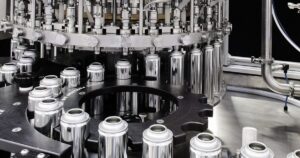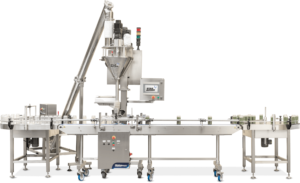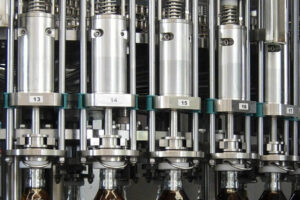Comprehending a Filling Machine for Cream
A cream-filling machine is a unique device used to fill pastries, sweets, and other food products with cream, custard, or other fillings accurately and efficiently. There are different types of these machines including piston fillers, rotary fillers, volumetric fillers, auger fillers, and manual fillers which are designed for specific production needs.
Typically the process of filling involves the preparation of cream or filling mixture; loading it into the hopper of the machine; adjusting settings for volume and speed of filling; and then dispensing this mixture into pastries or confections. The machine ensures uniformity in levels filled, minimizing wastage while maximizing consistency across products.
Accuracy, versatility, speediness in cleaning, durability, automation capabilities, and safety precautions should be among the key factors considered when choosing a cream-filling machine. This equipment finds various applications within the food industry such as bakeries, confectioneries, and snack productions among others.
To sum up, cream-filling machines help to streamline production processes, enhance the quality of finished goods, and meet customer demands in competitive markets.
Points to Look Out For
Precision Filling: Good cream filling machines must have precise filling capabilities that will ensure the correct dosage of whipped creams into cakes and other confectioneries.
Versatility: Machines should be able to handle different types of creams including whipped creams, and custard creams among others hence providing flexibility during production stages.
Ease Of Cleaning: Components that can easily be cleaned reduce downtime between runs thus maintaining hygiene standards throughout the operation period.
Automation: This feature enhances efficiency by allowing programmed settings that automatically adjust according size or shape required for each product during processing thereby reducing waste materials involved in this activity as well as time taken per unit produced.
Durability: Consider purchasing those made from strong materials since they are designed to withstand continuous use under commercial conditions where they may frequently come into contact with highly corrosive substances like acids found in some cream fillings.
Hygienic Design: A machine with food-grade materials designed in such a way that it meets sanitary requirements will help avoid contamination risks associated with product safety standards.
Speed And Capacity: In selecting one you need to take into account your desired production volumes per day or hour as well as how fast should these quantities be achieved thus determining the most suitable type of cream-filling machine for business needs.
Different Kinds Of Cream Filling Machines Are
Piston Filling Machines: these work by using piston mechanisms to accurately dispense creams into containers or onto products, this is most applicable when dealing with high-viscosity creams.

Rotary Filling Machines: they utilize rotary mechanisms to fill many containers at once which makes them the perfect choice especially if operating an assembly line where large numbers have to be handled within the shortest time possible.

Auger Filling Machines: here augers screws are used while dispensing creams into various containers, mostly preferred when working with thick and chunky fillings like peanut butter or cream cheese which may clog other types of machines.

Vacuum Filling Machines: vacuum technology plays a vital role in ensuring precise filling of delicate pastries through minimal air incorporation while still maintaining accuracy levels needed for this process; it works best for light-weight products such as puff pastry shells among others.

Automatic Depositors: they offer fully automated cream filling capabilities whereby dosage can be programmed into them thus giving consistent results every time during production.

The Process of Filling
Below are the steps typically involved in the filling process using any cream filler;
Preparation: Ensure that the recipe gives the right consistency and taste required for good quality filled products that have been followed during the preparation stage.
Loading: Hygienically load the prepared mixture (cream) into the hopper provided on the top part of the machine before starting the operation. Make sure cleanliness is observed throughout this exercise so as not to compromise outcome hygiene-wise.
Adjustment: Adjust settings like volume speed etc according to specifications given by the manufacturer then apply necessary changes if need be until the desired result is achieved after every test run is done using a trial batch.
Filling: Switch on the power button which activates the motor responsible for driving the pistons up and down thus causing them to suck fill cream into respective containers or onto products directly. Continue doing this until all requirements have been filled as uniformly and accurately as possible across batches.
Advantages of Cream Fillers
There are several benefits associated with the use of filling machines for creams and some include the following;
Improved Efficiency: These devices automate the entire process thereby reducing the amount of manual labor involved hence increasing productivity levels within the given time frame.
Consistency: These machines ensure even filling volumes and quality of products by having the capacity to dose accurately, which builds up the reputation of a brand.
Cost Savings: In saving on costs in the long term, cream-filling machines work towards reducing product wastage as well as optimizing workflow during production.
Hygiene and Food Safety: Sanitary design and easy-to-clean parts reduce risks such as contamination thereby ensuring compliance with food safety regulations.
Versatility: Cream fillers can take care of different types of creams and other goods helping manufacturers diversify their range while meeting various consumer needs.
Applications of Cream Filling Machines
Cream-filling machines have a wide range of uses within the food industry. Some examples include;
Bakery sector: Filling pastries, cakes, donuts, etc., with cream fillings.
Confectionery sector: Filling chocolates, truffles, or candies that have creamy centers.
Dairy Sector: Filling yogurt cups, ice cream cones, or frozen desserts having creamy toppings.
Snack Foods Sector: sandwich cookies filled with creamy fillings such as snack bars or wafers.
Food Service Sector: ready-to-eat meals filled with savory/sweet cream fillings for sandwiches/wraps among others.
Rating and Reviews
Performance, reliability, and ease-of-use customer support are some factors used when rating cream-filling machines. Even though there might be variations in specific ratings depending on brand/model; here is an example of top-rated manufacturers according to customers’ feedback;
Hinds-Bock Corporation: known for high-quality piston fillers and automatic depositing systems they offer precision together with durability thus being highly rated by many users.
Volumetric Technologies Inc.: offers efficient solutions through rotary fillers mainly used in high-speed production lines thereby gaining a good reputation due to their reliability/versatility aspects.
Reiser Company Limited Partnership: vacuum-based technology is used gently handling delicate products like candy bars during this process where accuracy plays a major role making them a favorite choice among confectionery producers.
Unifiller Systems Inc: auger fillers and automatic depositors have been recognized as innovative tools by bakers & confectioners alike who rely on them for their versatility along with ease-of-use features which contribute greatly towards customer satisfaction ratings.
Future Trends
Looking forward to future developments; cream-filling machines are expected to undergo exciting technological advancements such as:
Integration of IoT and Industry 4.0: Filling machines that can be monitored remotely, allow predictive maintenance or optimize production process based on data collected
Enhanced Automation and Robotics: Robotic arms equipped with vision systems will enable a more efficient and accurate filling process thus cutting down the time taken in this activity while ensuring higher levels of accuracy too.
Sustainable Solutions: Manufacturers should start looking at ways through which they could minimize environmental impacts caused by their activities e.g., using bio-degradable materials, energy-saving appliances, etc., because people expect businesses to adopt greener practices nowadays due to increased awareness about climate change issues globally.
Customization/Personalization: Producers need machines having modular designs or settings that can be changed according to individual preferences to come up with unique products hence driving innovation within the industry itself besides engaging consumers more effectively.
